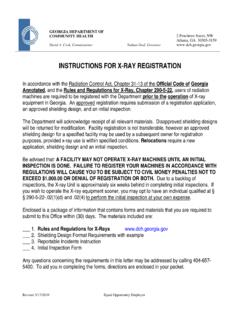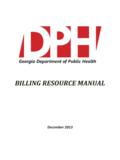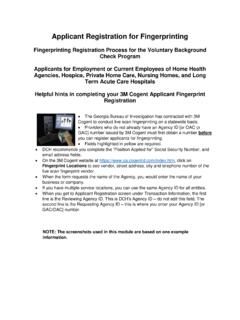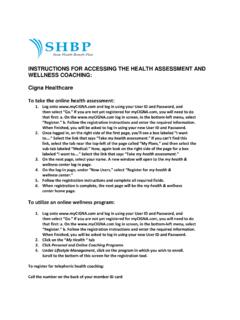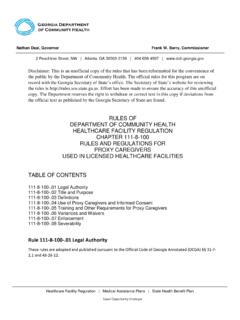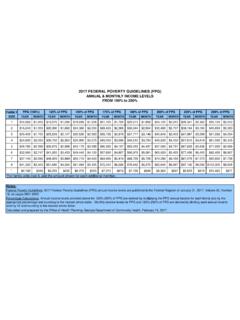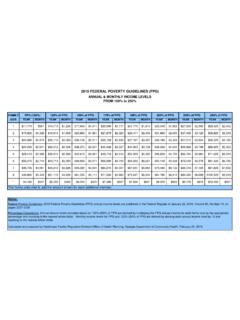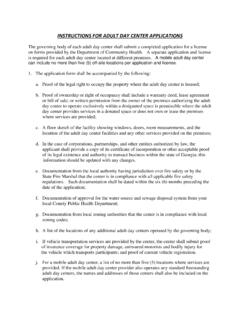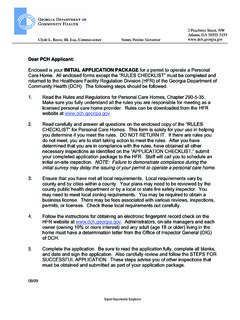Transcription of Rules for Assisted Living Communities—Interpretive ...
1 Rules for Assisted Living Communities Interpretive Guidelines Chapter 111-8-63, Rules for Assisted Living Communities Guidelines posted February 2, 2012 Effective January 2, 2012 Page 1 of 94 This is an unofficial copy of the Rules that has been reformatted for the convenience of the public by the Department of Community Health. The official Rules for this program are on record with the Georgia Secretary of State s office. The Secretary of State s website for reviewing the Rules is Effort has been made to ensure the accuracy of this unofficial copy. The Department reserves the right to withdraw or correct text in this copy if deviations from the official text as published by the Georgia Secretary of State are found.
2 Clarification for Providers (This information is intended to clarify Rules and to provide technical assistance and examples for providers with occasional notes on how surveyors may survey for a particular requirement. Such clarification and examples are subject to change from time to time as necessary to better reflect rule requirements. Any references which may be made to Best Practices are suggestions for raising the quality of care but are not requirements at this time. References to other related Rules may be provided here to assist the reader in finding information.) Authority. The legal authority for this Chapter is found in 31-2-7 and Chapter 7 of Title 31.
3 Authority 31-2-4, 31-2-7, 31-2-8, 31-2-9 and 31-7-1, et seq. Purpose. The purpose of these Rules and regulations is to establish the minimum standards for the operation of personal care homes to be licensed as Assisted Living communities. Such communities provide Assisted Living care to adults who require varying degrees of assistance with the activities of daily Living but who do not require continuous medical or nursing care. These Rules establish minimum requirements that Assisted Living communities must meet to obtain and retain their permit to operate the community. Individual communities may be required to exceed these minimum requirements as explained in the Rules to meet the specific health and safety needs of their resident population.
4 This is particularly applicable for communities choosing to serve special populations such as Alzheimer s residents. Safety needs include an ability of the community to evacuate the residents in the event of an emergency. Authority 31-2-7 and 31-7-1 et seq. Definitions. In these Rules , unless the context otherwise requires, the words, phrases and symbols set forth herein shall mean the following: (a) "Abuse " means any intentional or grossly negligent act or series of acts or intentional or grossly negligent omission to act which causes injury to a resident, including but not limited to, assault or battery, failure to provide treatment or care, or sexual harassment of the resident.
5 Rules for Assisted Living Communities Interpretive Guidelines Chapter 111-8-63, Rules for Assisted Living Communities Guidelines posted February 2, 2012 Effective January 2, 2012 Page 2 of 94 (b) "Activities of daily Living " means bathing, shaving, brushing teeth, combing hair, toileting, dressing, eating, walking, transferring from place to place, laundering, cleaning room, managing money, writing letters, shopping, using public transportation, making telephone calls, grooming, obtaining appointments, engaging in leisure and recreational activities, or other similar activities. Activities of daily Living are the routine things that one does to live a healthy and safe life.
6 (c) "Administrator" means the manager designated by the Governing Body as responsible for the day-to-day management, administration and supervision of the Assisted Living community, who may also serve as the on-site manager and responsible staff person except during periods of his or her own absence. (d) Applicant means an individual or entity that submits an application for licensure pursuant to these Rules as described below: 1. When the Assisted Living community is owned by a sole proprietorship, the individual proprietor must be the applicant for the license, complete the statement of responsibility and serve as the licensee; 2. When the Assisted Living community is owned by a partnership, the general partners must be the applicant for the license, complete the statement of responsibility and serve as the licensee; 3.
7 When the Assisted Living community is owned by an association, limited liability company (LLC), the governing body of the association or LLC must authorize the application for the license, complete the statement of responsibility and serve as the licensee; and 4. When the Assisted Living community is owned by a corporation, the governing body of the corporation must authorize the application for the license, complete the statement of responsibility and serve as the licensee. Rules for Assisted Living Communities Interpretive Guidelines Chapter 111-8-63, Rules for Assisted Living Communities Guidelines posted February 2, 2012 Effective January 2, 2012 Page 3 of 94 (e)
8 Assistive device means a device that may restrain movement which has been determined to be required by a licensed physician, nurse practitioner or physician s assistant working under a protocol or job description respectively and is applied for protection from injury or to support or correct the body alignment of the person, , for the treatment of a person s physical condition, and may only be used as a treatment intervention where a specific written plan of care has been developed and the resident consents to such use. There must be a medical order, a specific written plan of care detailing how the assistive device is to be used, released, etc. and the resident must consent to the use of the assistive device.
9 (f) Assisted Living care means the specialized care and services provided by an Assisted Living community which includes the provision of personal services, the administration of medications by a certified medication aide and the provision of Assisted self preservation. In order to qualify to be licensed as an Assisted Living community, the community must offer 1. personal services, 2. administration of medications by certified medication aides and 3. Assisted self-preservation. (g) Assisted Living community or community means a personal care home serving 25 residents or more that is licensed by the department to provide Assisted Living care. Personal care homes with 25 or more beds have the option of deciding whether they want to apply to become licensed under the Assisted Living Community Rules .
10 However, if the home offers Assisted Living care as defined in these Rules , it must be licensed as an Assisted Living community. Rules for Assisted Living Communities Interpretive Guidelines Chapter 111-8-63, Rules for Assisted Living Communities Guidelines posted February 2, 2012 Effective January 2, 2012 Page 4 of 94 (h) Assisted self-preservation means the capacity of a resident to be evacuated from an Assisted Living community to a designated point of safety and within an established period of time as determined by the Office of fire Safety Commissioner. Assisted self-preservation is a function of all of the following: (A) the condition of the individual, (B) the assistance that is available to be provided to the individual by the staff of the Assisted Living community; and (C) the construction of the building in which the Assisted Living community is housed, including whether such building meets the state fire safety requirements applicable to an existing health care occupancy.
